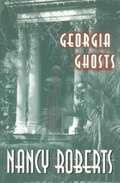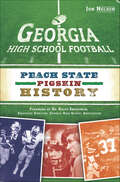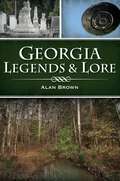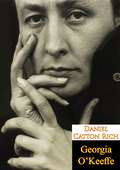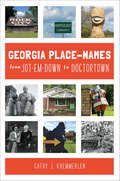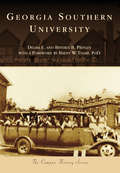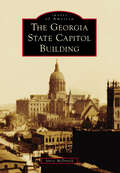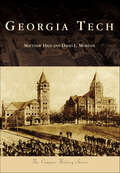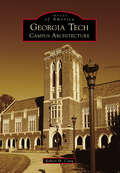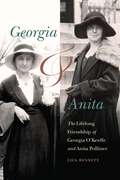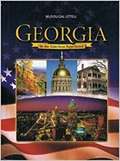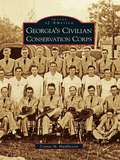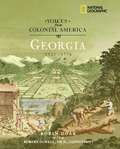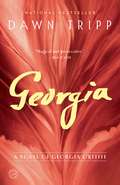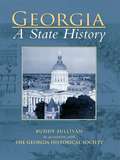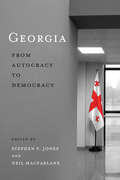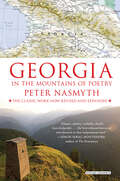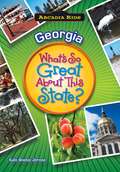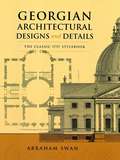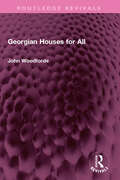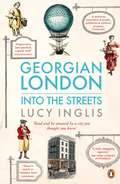- Table View
- List View
Georgia Ghosts
by Nancy RobertsIncludes over 50 stories of ghosts from across the state of Georgia.
Georgia High School Football: Peach State Pigskin History (Sports)
by Jon NelsonGeorgia is known as one of the most competitive proving grounds in America for high school football. The league that began as a few city teams in the late nineteenth century blossomed to the four hundred-plus schools that put teams on the field today. These teams have given college football and the professional ranks their share of champions. As schools across the state continue to chase�and break�records, a century of winning is only the beginning of Georgia�s dynamic high school football legacy. Jon Nelson guides readers through an unparalleled history of coaches, towns and dynasties that have led Georgia to become one of the top five most competitive football states in the country.
Georgia Legends & Lore (American Legends)
by Alan BrownSettle in for a juicy bushel of Peach State bafflement.
Georgia O’Keeffe
by Daniel Catton RichThis is the definitive book on Georgia O'Keeffe's work--selected, designed, and supervised by the artist herself, with her own text. It includes 108 magnificent full-color plates, some never reproduced elsewhere or publicly shown, and spans O'Keeffe's entire career: from her intense, personal abstractions to her unique depictions of nature--flowers, bones, rocks, and landscapes.
Georgia Place-Names From Jot-em-Down to Doctortown
by Cathy J. KaemmerlenEver wonder how Rough and Ready got its name? Or what Stonesthrow is a stone's throw from? And surely the story behind Climax can't be…that thrilling, can it? The curious Georgian can't help pondering the seemingly endless supply of head-scratching place names that dot this state. Luckily, the intrepid Cathy Kaemmerlen stands ready to unravel the enigmas--Enigma is, in fact, a Georgia town--behind the state's most astonishing appellations. Cow Hell, Gum Pond, Boxankle and Lord a Mercy Cove? One town owes its name to a random sign that fell off a railcar, while another memorializes a broken bone suffered by a cockfight spectator. And just how many place names were inspired by insolent mules? Come on in to find out.
Georgia Southern University
by Brent Tharp Delma E. Presley Beverly B. PresleyIn 1906, the founders of what would become Georgia Southern University pledged to build a college that would prepare students to succeed in a changing world. The First District Agricultural and Mechanical School served well the needs of women and men who lived in a farm-based economy. As the 20th century unfolded, the college did something that is rare in the history of higher education: it changed its name five times to meet the educational needs of its citizens. A university since 1990, Georgia Southern provides opportunities for a diverse and inclusive student body that now exceeds 20,000. Each year, graduates earn diplomas at the bachelors, masters, and doctoral levels. Today, the road to the future begins on a path that learners long have traveled: it leads up through a green forest to Sweetheart Circle. Old A&M has become one of the nation's distinctive universities. Those who study and teach here say the campus is the most beautiful in America. At its heart is a pair of neatly coupled lakes, framed by historic willows, live oaks, and stately pines. The light of learning still shines brightly from Statesboro's highest hill.
Georgia State Capitol Building, The (Images of America)
by Janice McDonaldSeveral Georgia cities had already served as capital when in 1868 the controversial decision was made to move the seat of state government to the upstart city of Atlanta, a move that became permanent in 1877. When government offices outgrew temporary quarters, a grand new structure was commissioned. Designed to emulate the new US Capitol Building in Washington, DC, the Georgia State Capitol building plans carried an unheard-of price tag of $1 million, taking four years to construct. With its imposing edifice rising 272 feet above one of the highest spots in the city, the capitol was the tallest building in Atlanta when it was dedicated on July 4, 1889. The imposing dome at its center was white plaster, but in the 1950s, gold mined in north Georgia was used to guild it. The glimmering Georgia State Capitol now shines at the center of still growing Atlanta skyline. Author Janice McDonald is fascinated by the rich history of her adopted city of Atlanta and has spent countless hours researching and exploring to learn more about it. The capitol's origins, its construction, and the people who have walked its halls are just some of the stories that make the Georgia State Capitol so memorable.
Georgia Tech (Campus History)
by Matthew HildGeorgia Tech has become one of the nation's top-10-ranked public universities and boasts a former U.S. president, TV personality and Hall-of-Fame athletes among its prominent alumni.From humble beginnings as a small technological institute that opened in 1888, Georgia Tech is now renowned throughout the world for its excellence in technological education and research. A top-10-ranked public university, according to U.S. News & World Report rankings, famous Georgia Institute of Technology alumni include Jimmy Carter, G. Wayne Clough, Jeff Foxworthy, Sam Nunn, Randolph Scott, and Leonard Wood, along with many famous athletes. Georgia Tech has won four national college football championships, the first in 1917 under the legendary coach John Heisman. Today, Georgia Tech has a student body of more than 29,000 at the undergraduate and graduate levels and more than 155,000 living alumni. The institute has an annual economic impact of about $3 billion upon Georgia's economy. Authors and Tech alumni Matthew Hild and David L. Morton take you inside the journey of how this institute got to where it is today.
Georgia Tech: Campus Architecture (Images of America)
by Robert M. CraigThe architectural development of Georgia Tech began as a core of Victorian-era buildings sited around a campus green and Tech Tower. During the subsequent Beaux-Arts era, designers (who were also members of the architecture faculty) added traditionally styled buildings, with many of them in a pseudo-Jacobean collegiate redbrick style. Early Modernist Paul Heffernan led an architectural revolution in his academic village of functionalist buildings on campus--an aesthetic that inspired additional International Style campus buildings. Formalist, Brutalist, and Post-Modern architecture followed, and when Georgia Tech was selected as the Olympic Village for the 1996 Summer Olympics, new residence halls were added to the campus. Between 1994 and 2008, Georgia Tech president G. Wayne Clough stewarded over $1 billion in capital improvements at the school, notably engaging midtown Atlanta with the development of Technology Square. The landscape design by recent campus planners is especially noteworthy, featuring a purposeful designation of open spaces, accommodations for pedestrian perambulations, and public art. What might have developed into a prosaic assemblage of academic and research buildings has instead evolved into a remarkably competent assemblage of aesthetically pleasing architecture.
Georgia and Anita: The Lifelong Friendship of Georgia O'Keeffe and Anita Pollitzer
by Liza BennettGeorgia O&’Keeffe knew as soon as she met Anita Pollitzer that they had nothing in common. Anita looked like a china doll, small boned and delicate, and obviously well-to-do in her fashionable tunics and hobble skirts. She had the kind of mouth that settled naturally into a smile, which irritated O&’Keeffe, who had no time for dewy-eyed girls. Yet this first impression was the beginning of a lifelong friendship that had a tremendous impact on both women and on twentieth-century America. In Georgia and Anita Liza Bennett tells the little-known story of their enduring friendship and its ultimately tragic arc. It was Pollitzer who first showed O&’Keeffe&’s work to family friend and mentor Alfred Stieglitz, the world-famous photographer whose 291 Gallery in New York City was the epicenter of the modern art world. While O&’Keeffe, Stieglitz, and their circle of friends were at the forefront of American modernism, Pollitzer became a leader of the National Woman&’s Party and was instrumental in the passage of the Nineteenth Amendment, guaranteeing women the right to vote. Based on extensive research, including their fifty-year correspondence, Georgia and Anita casts light on the friendship of these two women who, in different ways, helped to modernize the world and women&’s roles in it. For more information about Georgia and Anita, visit georgiaandanita.com.
Georgia and the American Experience
by Bonnie Bullard LondonThis textbook on Georgia explores the history and geography of Georgia and includes in Appendix: Georgia Vital Statistics, Georgia Counties, Georgia Governors, Georgia Colleges and Universities, and Georgia Atlas.
Georgia in the American Experience (McDougal Littell Georgia State American History Ser.)
by Patricia Klein Craig PascoeGeorgia in the American Experience
Georgia's Civilian Conservation Corps
by Connie M. HuddlestonAt a time when our country struggled with a deep financial depression, the United States began to see incredible numbers of men and women who could not find work. During the first days of his administration, Pres. Franklin D. Roosevelt sought to create opportunities for this country's uneducated and undereducated young men to find work, help support their families, and receive training in a variety of fields. President Roosevelt's own vision brought about the Civilian Conservation Corps (CCC). Images of America: Georgia's Civilian Conservation Corps examines the role these young men played in developing three national forests, three national monuments, a national battlefield, 10 state parks, and four military installations. This book illustrates and gives voice to the CCC's rich contribution to Georgia's landscape and history and allows us to understand how the creation of this social employment program was once seen as the shining example of FDR's New Deal.
Georgia, 1521-1776 (National Geographic Voices From Colonial America)
by Robert Olwell Robin Santos DoakDid you know that the treasure of the infamous pirate Blackbeard is probably buried on one of the islands off Georgia? And did you know of the dastardly deed of Spanish privateers that provoked the War of Jenkins's Ear? <p><p> James Oglethorpe's "noble experiment" to make Georgia a place where debtors got a second chance and slavery and alcohol were banned was destroyed by "malcontents." Plantations producing rice and indigo increased the demand for slave labor, and the rift between the coastal planters and poorer upcountry farmers quickly divided the colony. This division would also complicate Georgia's decision to join the other colonies in the fight for independence.
Georgia: A Novel of Georgia O'Keeffe
by Dawn TrippNATIONAL BESTSELLER * In a dazzling work of historical fiction in the vein of Nancy Horan's Loving Frank, Dawn Tripp brings to life Georgia O'Keeffe, her love affair with photographer Alfred Stieglitz, and her quest to become an independent artist. This is not a love story. If it were, we would have the same story. But he has his, and I have mine. In 1916, Georgia O'Keeffe is a young, unknown art teacher when she travels to New York to meet Stieglitz, the famed photographer and art dealer, who has discovered O'Keeffe's work and exhibits it in his gallery. Their connection is instantaneous. O'Keeffe is quickly drawn into Stieglitz's sophisticated world, becoming his mistress, protégé, and muse, as their attraction deepens into an intense and tempestuous relationship and his photographs of her, both clothed and nude, create a sensation. Yet as her own creative force develops, Georgia begins to push back against what critics and others are saying about her and her art. And soon she must make difficult choices to live a life she believes in.A breathtaking work of the imagination, Georgia is the story of a passionate young woman, her search for love and artistic freedom, the sacrifices she will face, and the bold vision that will make her a legend.Praise for Georgia"Complex and original . . . Georgia conveys O'Keeffe's joys and disappointments, rendering both the woman and the artist with keenness and consideration."--The New York Times Book Review"As magical and provocative as O'Keeffe's lush paintings of flowers that upended the art world in the 1920s . . . Tripp inhabits Georgia's psyche so deeply that the reader can practically feel the paintbrush in hand as she creates her abstract paintings and New Mexico landscapes. . . . Evocative from the first page to the last, Tripp's Georgia is a romantic yet realistic exploration of the sacrifices one of the foremost artists of the twentieth century made for love."--USA Today "Sexually charged . . . insightful . . . Dawn Tripp humanizes an artist who is seen in biographies as more icon than woman. Her sensuous novel is as finely rendered as an O'Keeffe painting."--The Denver Post"A vivid work forged from the actual events of O'Keeffe's life . . . [Tripp] imbues the novel with a protagonist who forces the reader to consider the breadth of O'Keeffe's talent, business savvy, courage and wanderlust. . . . [She] is vividly alive as she grapples with success, fame, integrity, love and family."--Salon "Masterful . . . The book is a lovely portrayal of an iconic artist who is independent and multidimensional. Tripp's O'Keeffe is a woman hoping to break free of conventional definitions of art, life and gender, as well as a woman of deep passion and love."--Milwaukee Journal Sentinel "O'Keeffe blazes across the pages in Tripp's tour de force about this indomitable woman. . . . Tripp has hit her stride here, bringing to life one of the most remarkable artists of the twentieth century with veracity, heart, and panache."--Publishers Weekly (starred review)"I devoured this dazzling novel about an American icon. Dawn Tripp brings Georgia O'Keeffe so fully to life on every page and, with great wisdom, examines the very nature of love, longing, femininity, and art."--J. Courtney Sullivan, New York Times bestselling author of Maine and The EngagementsFrom the Hardcover edition.
Georgia: A State History (The\making Of America Ser.)
by Buddy Sullivan Georgia Historical SocietyGeorgia's past has diverged from the nation's and given the state and its people a distinctive culture and character. Some of the best, and the worst, aspects of American and Southern history can be found in the story of what is arguably the most important state in the South. Yet just as clearly Georgia has not always followed the road traveled by the rest of the nation and the region. Explaining the common and divergent paths that make us who we are is one reason the Georgia Historical Society has collaborated with Buddy Sullivan and Arcadia Publishing to produce Georgia: A State History, the first full-length history of the state produced in nearly a generation. Sullivan's lively account draws upon the vast archival and photographic collections of the Georgia Historical Society to trace the development of Georgia's politics, economy, and society and relates the stories of the people, both great and small, who shaped our destiny. This book opens a window on our rich and sometimes tragic past and reveals to all of us the fascinating complexity of what it means to be a Georgian.
Georgia: From Autocracy to Democracy (Thirdworlds Ser.)
by Stephen F. Jones Neil MacFarlaneReflecting on the deep and complex changes in Georgian politics over the last quarter of a century, this book highlights the domestic and international developments that have shaped Georgia as a state and society. Georgia: From Autocracy to Democracy covers a wide array of topics, including the economy, elections, judicial and educational systems, relations with the European Union, and Georgia’s interaction with its regional neighbours, including Russia, Turkey, and Iran. In the book, Georgian policy-makers, practitioners, and scholars who have worked in the administration, in the opposition, in the Third Sector, and in academia provide first-hand perspectives on Georgia’s political and economic life. They demonstrate exceptional insight into the extraordinary transformations in Georgia over the last twenty-five years, from the authoritarianism of President Zviad Gamsakhurdia, through the experience of civil war in the 1990s, to democracy today.
Georgia: In the Mountains of Poetry (Caucasus World: Peoples Of The Caucasus Ser.)
by Peter Nasmyth&“Elegiac, quirky, readable, deeply knowledgeable . . . The best cultural-historical introduction to that tempestuous land,&” the Georgian republic. (Simon Sebag Montefiore, author of The Romanovs) Georgia has been called the world&’s most beautiful country, yet little is known about it beyond its borders. This topical and vital book by Peter Nasmyth, the &“ideal chronicler&” (Literary Review) is the much-celebrated introduction to Georgia&’s remarkable people, landscape, and culture. Over its 3,000-year-old history, Georgia has been ruled by everyone from the Greeks to the Ottomans, became a coveted part of the Russian Empire for a hundred years, and was incorporated into the Soviet Union in 1921. Since gaining independence in 1991, Georgia has undergone a dramatic socioeconomical and political transformation, and although its political situation remains precarious, Georgia&’s strong sense of nationhood has reinvigorated the country. Vivid and comprehensive, Nasmyth&’s Georgia: In the Mountains of Poetry is a unique eyewitness account of Georgia&’s rebirth and creates an unforgettable portrait of its remarkable landscape, history, people and culture. Offering fascinating insights into the life of ordinary and high profile Georgians, it is essential reading for anyone who wants to know more of this astonishing place. &“The best book on post-Soviet Georgia . . . Nasmyth is prepared to take risks―hanging out with mafiosi and walking through minefields to reach that part of western Georgia that has bloodily seceded . . . a riveting portrait . . . powerfully evocative.&” —Independent &“It would be difficult to read Nasmyth's quirky, entertaining, informative, sometimes surreal book without having an impulse to ring a travel agent and ask for flights to Tblisi.&” —LiteraryReview
Georgia: What's So Great About This State?
by Kate Boehm JeromeWHY does the land in the Okefenokee Swamp seems to move? WHAT threatened the entire Georgia cotton business in the early 1920s? Find these answers and more in the Georgia edition of What's So Great About This State?
Georgian Architectural Designs and Details: The Classic 1757 Stylebook
by Abraham SwanAmong the 18th century's most influential architectural designers and writers, Abraham Swan defined many conventions of English rococo detail. This reprint of an extremely rare and classic stylebook, compiled by the English architect nearly 250 years ago, provides outstanding examples of Palladian and Georgian architecture and design in colonial America and England.Included are floor plans, detailed elevations, and drawings for cornices, mouldings, and other decorative elements that demonstrate Swan's unique style. Designed, in his words, more for "Gentlemen of moderate Fortunes than of great Estates who may be inclined to build Houses," Swan's designs featured such aesthetic touches as double staircases, elegant entryways, and two or three floors with spacious galleries, salons, and dressing rooms.Invaluable to architectural historians and designers, this splendid stylebook will delight devotees of early English Georgian and American domestic architecture and interior design, cultural historians, artists, and craftworkers.
Georgian Houses for All (Routledge Revivals)
by John WoodfordeFirst published in 1978, Georgian Houses for All describes how little Gregorian houses came into being and how the original inhabitants used them. Gregorian houses at their smallest and simplest can be seen everywhere in the British Isles – detached, semi-detached and joined together in terraces. There are probably still over a million of them, built during a period of 130 years without the direct aid of architects. John Woodforde points out that an instinctive wish for a symmetrical front seems to be shown by young children’s drawings of houses, these being generally balanced and orderly. The Georgians’ love of symmetry, marked in their way of hanging pictures, was part of a desire for private order amongst public disorder, a desire to have one small sphere in which nature was fully controlled. John Woodforde reminds us that, in the present-day return to terrace-house building, the Georgian version remains a valuable guide. The book will be of interest to students of architecture, urban planning, and history.
Georgian Internally Displaced People: The Formation of a Social Identity
by Hazar Ege Gürsoy ErdenayThis book explores the construction of Internally Displaced Persons (IDPs) identity as a social group in Georgia, framed through Tajfel and Turner's Social Identity Theory. It examines the key factors shaping the identity of Georgian IDPs displaced by ethnic conflicts in two major migration waves (the early 1990s and 2008) from Abkhazia and South Ossetia. Divided into two parts, the study first looks at the historical context of the ethnic conflicts and the state's responses to displacement. The second part focuses on the formation of IDP identity, analyzing how external definitions by the host community have perpetuated devaluation? throughout the post-Soviet period. It also highlights the self-perceptions, characteristics and tactics that have helped transform IDP identity from a devalued label to a more positive and resilient social identity.
Georgian London: Into the Streets
by Lucy InglisIn Georgian London: Into the Streets, Lucy Inglis takes readers on a tour of London's most formative age - the age of love, sex, intellect, art, great ambition and fantastic ruin. Travel back to the Georgian years, a time that changed expectations of what life could be. Peek into the gilded drawing rooms of the aristocracy, walk down the quiet avenues of the new middle class, and crouch in the damp doorways of the poor. But watch your wallet - tourists make perfect prey for the thriving community of hawkers, prostitutes and scavengers. Visit the madhouses of Hackney, the workshops of Soho and the mean streets of Cheapside. Have a coffee in the city, check the stock exchange, and pop into St Paul's to see progress on the new dome.This book is about the Georgians who called London their home, from dukes and artists to rent boys and hot air balloonists meeting dog-nappers and life-models along the way. It investigates the legacies they left us in architecture and art, science and society, and shows the making of the capital millions know and love today.'Read and be amazed by a city you thought you knew' Jonathan Foyle, World Monuments Fund'Jam-packed with unusual insights and facts. A great read from a talented new historian' Independent'Pacy, superbly researched. The real sparkle lies in its relentless cavalcade of insightful anecdotes . . . There's much to treasure here' Londonist'Inglis has a good ear for the outlandish, the farcical, the bizarre and the macabre. A wonderful popular history of Hanoverian London' London Historians
